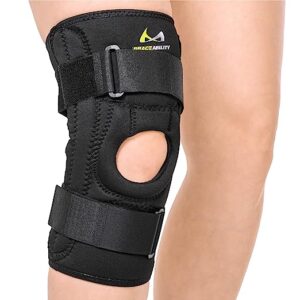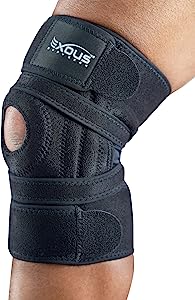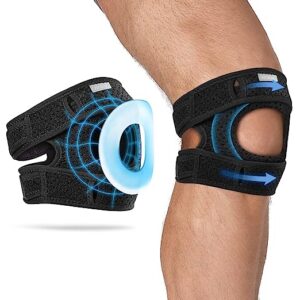Chondromalacia, also known as patellofemoral pain syndrome, is a common knee condition that affects people of all ages. It occurs when the cartilage on the underside of the kneecap becomes soft or damaged, leading to pain, inflammation, and discomfort. If you’ve been diagnosed with chondromalacia, you may find relief and support from using a knee brace. In this blog, we will explore the benefits and considerations of using a knee brace as part of your treatment plan for chondromalacia.
Table: Best Knee Brace for Chondromalacia in 2023
1. BraceAbility Chondromalacia Knee Brace
The BraceAbility Chondromalacia Knee Brace is a top-notch solution for individuals seeking effective support and pain management for knee conditions like chondromalacia and patellofemoral pain syndrome. With its U-shaped padded buttress providing enhanced patellar support and reduced strain on the kneecap’s cartilage, this lightweight and breathable knee brace is perfect for active lifestyles. Its convenient pull-on style and adjustable compression straps ensure a secure fit, preventing any sliding down during physical activities. From tendon tears to runner’s knee and more, this versatile brace tackles various knee issues, making it an ideal choice for regaining comfort and maintaining an active lifestyle.
Designed with the specific needs of individuals with chondromalacia and patellofemoral pain syndrome in mind, the BraceAbility Chondromalacia Knee Brace offers exceptional support and pain relief. Crafted from a breathable neoprene alternative, this knee brace is lightweight and comfortable, making it perfect for an active lifestyle. Whether you’re engaged in physical activity, walking, running, cycling, or hiking, this brace remains securely in place with its convenient pull-on style and adjustable compression straps. Not only does it treat and manage chondromalacia, but it also addresses various knee conditions such as tendon tears, patella alta/baja, knee bursitis, and more.
2. EXOUS BODYGEAR Knee Brace
Experience unparalleled stability and support with the EXOUS BODYGEAR Chondromalacia Knee Brace. Its innovative design, featuring a full 360-degree stabilizing support, ensures dependable knee stabilization. The 4-way patented strap design, with four independent compression anchor points and dedicated patellar tracking, effectively relieves pain associated with jumper’s knee, patella tendonitis, and meniscus tears. This brace is suitable for both men and women, fitting comfortably on left or right knees.
Whether you engage in soccer, running, hiking, or skiing, this knee brace is tailored to provide supportive lateral and medial ligament protection. Its 360-degree dual cross torsion compression offers the best neoprene open patella support available on the market, allowing you to pursue your favorite activities with confidence. Unlike generic 2 and 3-strap open patellar knee braces that slide down while walking, causing annoyance and itching, the EXOUS BODYGEAR Knee Brace is specifically engineered to address these common flaws. It stays in place, providing superior knee support, making it ideal for arthritis, osteoarthritis, and dislocation cases. With its slimline profile and weighing less than 6 ounces, this brace offers maximum support and stabilization without sacrificing comfort.
3. Fit Geno Patella Knee Brace
The Fit Geno 1-Pack Patella Knee Brace is a must-have for individuals seeking reliable support for knee injuries and arthritis. Its multiple buckle holes ensure a one-size-fits-all approach, while the shock-absorbing cushion provides excellent support and comfort. The flexible and adjustable multi-hole buckle design allows for personalized fit and adaptability to your unique needs. Whether you’re engaged in intense physical activities or exercise routines, this knee brace keeps your patella securely in place, providing stability and reducing the risk of injury.
The Fit Geno Patella Knee Brace offers both lightweight and comfortable support. Made from durable and breathable materials, it effectively relieves tension and joint pain by minimizing the force exerted on the quadriceps. Its ergonomic design, coupled with the non-slip Velcro feature, guarantees a secure and snug fit, allowing you to perform various activities such as working out, playing basketball, running, hiking, and weightlifting with confidence.
Understanding Chondromalacia
Chondromalacia, also referred to as patellofemoral pain syndrome or runner’s knee, is a condition characterized by the softening, degeneration, or damage of the cartilage on the undersurface of the kneecap (patella). The patellar cartilage serves as a protective layer, allowing smooth movement of the knee joint during activities such as walking, running, or bending.
Chondromalacia often occurs as a result of factors like overuse, repetitive stress, muscle imbalances, improper alignment of the patella, or trauma to the knee. It is commonly experienced by athletes, particularly runners, as well as individuals who engage in activities that involve frequent knee bending or impact.
The main symptoms of chondromalacia include knee pain, especially when climbing stairs, squatting, or kneeling, as well as a sensation of grinding or popping within the knee joint. Swelling and aching may also be present. Treatment typically involves a combination of rest, physical therapy exercises to strengthen the surrounding muscles, pain management, and the use of supportive devices like knee braces. In more severe cases, medical interventions such as injections or surgery may be considered. It is important to consult with a healthcare professional for an accurate diagnosis and appropriate treatment plan tailored to individual needs.
The Role of Knee Braces for Chondromalacia
A knee brace is a medical device designed to provide stability, support, and compression to the knee joint. When it comes to chondromalacia, a knee brace can play a significant role in reducing pain, improving joint function, and preventing further damage. Here are some key benefits of using a knee brace:
- Pain Relief: The primary objective of a knee brace for chondromalacia is to alleviate pain. By providing gentle compression and support, the brace helps reduce pressure on the affected area, easing discomfort during movement and activities.
- Stabilization: A knee brace stabilizes the joint by limiting excessive movement. This stabilization reduces the strain on the kneecap, allowing the damaged cartilage to heal and preventing further deterioration.
- Corrective Alignment: Certain knee braces are designed to correct misalignment issues associated with chondromalacia. They help guide the patella (kneecap) into proper alignment, reducing the risk of irritation and friction between the patella and the femur.
- Enhanced Proprioception: Proprioception refers to your body’s awareness of its position and movement in space. A knee brace provides sensory feedback, enhancing your proprioception and promoting better knee joint control and coordination.
Choosing the Right Knee Brace
- Open or Closed Patella: Knee braces with an open patella design relieve pressure on the kneecap, while closed patella braces provide additional support and compression to the entire knee joint. Consult with your healthcare provider to determine which design suits your needs best.
- Size and Fit: It’s essential to choose a knee brace that fits you properly. Look for adjustable braces that can be customized to your measurements. Ensure a snug fit without excessive tightness, as it should provide support without causing discomfort or restricting circulation.
- Quality and Durability: Invest in a knee brace made from high-quality materials to ensure durability and longevity. Look for braces that offer breathability, moisture-wicking properties, and reliable fastening mechanisms.
When Does Chondromalacia Occur?
Chondromalacia typically occurs when there is an imbalance in the forces acting on the knee joint. It often manifests in individuals who participate in sports or activities that involve frequent bending of the knee, such as running, jumping, or cycling. Here are a few common situations in which chondromalacia may arise:
- Athletes: Athletes who participate in high-impact sports, such as basketball, volleyball, or golf are at an increased risk of developing chondromalacia. The repetitive stress and excessive use of the knee joint can lead to irritation and damage to the cartilage beneath the kneecap.
- Overuse or Training Errors: Engaging in excessive or improper training can contribute to the development of chondromalacia. Sudden increases in activity level, inadequate rest periods, and poor technique can place excessive strain on the knee joint, leading to cartilage damage over time.
- Muscle Imbalances: Weakness or imbalance in the muscles around the knee, particularly the quadriceps and hamstrings, can contribute to patellar misalignment. This misalignment can increase stress on the cartilage and result in chondromalacia.
Prevention Strategies for Chondromalacia
While chondromalacia can be challenging to completely prevent, implementing certain strategies can help minimize the risk of developing the condition. Here are some preventive measures to consider:
- Strengthening Exercises: Strengthening the muscles around the knee, especially the quadriceps and hamstrings, can help provide better support and stability to the joint. Including exercises like squats, lunges, leg presses, and hamstring curls in your fitness routine can help build strength and reduce the risk of chondromalacia.
- Proper Technique and Training: If you participate in sports or engage in activities that involve repetitive knee movements, it’s important to use proper technique and receive proper training. Ensure that you are using correct form and body mechanics to reduce excessive stress on the knee joint.
- Gradual Progression: Avoid sudden increases in activity level or training intensity. Gradually progress your exercise routine, allowing your body time to adapt and build strength. This approach can help prevent overuse injuries and cartilage damage associated with chondromalacia.
- Warm-up and Cool-down: Prior to engaging in physical activity, warm up your muscles and joints with dynamic stretches and light aerobic exercises. Cooling down afterward with static stretches can help reduce muscle tightness and prevent excessive stress on the knee joint.
- Cross-Training and Rest: Incorporating cross-training activities can help reduce the repetitive stress on the knee joint. Alternate between activities that involve different muscle groups and joint movements to give your knees a break from constant strain. Additionally, ensure you incorporate adequate rest days into your training schedule to allow for recovery.
FAQ
- Can a knee brace help with chondromalacia? Yes, a knee brace can be beneficial for individuals with chondromalacia. It provides support, stability, and compression to the knee joint, helping to alleviate pain, reduce strain, and promote healing. A knee brace can also aid in correcting misalignment issues associated with chondromalacia.
- What type of knee brace is suitable for chondromalacia? The type of knee brace suitable for chondromalacia depends on various factors, including the severity of the condition and individual needs. However, there are a few common types that are often recommended. Patellar stabilizing braces with a horseshoe-shaped buttress around the kneecap can help align and stabilize the patella. Neoprene sleeves or wraparound braces can provide compression and support to the knee joint. Consult with your healthcare professional to determine the best type of knee brace for your specific condition.
- When should I wear a knee brace for chondromalacia? A knee brace for chondromalacia can be worn during activities that involve repetitive knee movements or when you experience pain or discomfort. It is generally recommended to wear the brace during physical activities, such as walking, running, or sports, to provide support and reduce strain on the knee joint. However, it’s important to follow the guidance of your healthcare professional regarding the duration and specific situations in which you should wear the brace.
- Can I wear a knee brace all day for chondromalacia? The duration for wearing a knee brace for chondromalacia can vary depending on the severity of your symptoms and the recommendations of your healthcare professional. While it is typically safe to wear a knee brace for several hours during the day, it is important to allow your knee some rest and avoid prolonged reliance on the brace. Follow the guidelines provided by your healthcare professional to determine the appropriate duration of brace usage for your specific condition.
- Is a knee brace the only treatment option for chondromalacia? No, a knee brace is not the only treatment option for chondromalacia. It is often used as part of a comprehensive treatment plan that may include other interventions. Physical therapy exercises to strengthen the surrounding muscles, pain management strategies, lifestyle modifications, and activity modifications are commonly recommended alongside the use of a knee brace. It is crucial to consult with your healthcare professional to develop an individualized treatment plan that suits your specific needs.


